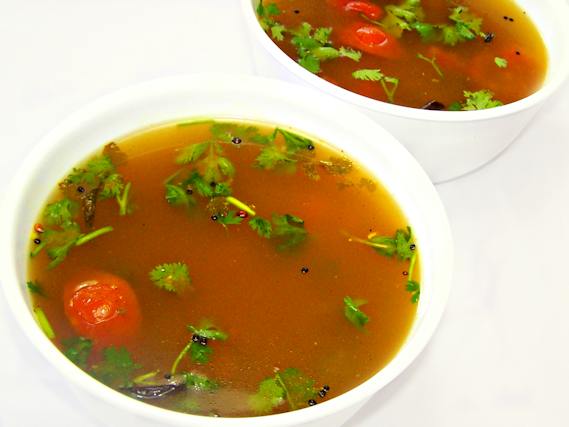Although Indian cuisine consists of a veritable rainbow of different dishes with an assortment of exotic flavours, textures and aromas that could satisfy any personal preference, there are a few die-hard, staple recipes that you will find consistently appearing on the Indian household menu.
Rasam – a South Indian Staple
One such recipe is the South Indian soup rasam. Although the word rasam means juice, this tangy speciality goes by a variety of interesting, alternative names with meanings that give a little insight into how important the dish is to Indian culinary culture. For example, in Kannadu it is referred to as saaru, roughly translating as essence. In Tamil, it is often known as chaathamudhu which is reminiscent of the Tamil word for ambrosia, the elixir of life. It is safe to say that this innocuous looking soup dish is considered to be a nourishing potion for both body and soul.
The Preparation of Rasam
A traditional rasam is prepared using the key ingredient of tamarind or tomato juice. This is where the tangy, sour flavour originates from. A generous helping of warming, Indian spices give the rasam its exotic flavour whilst the frequent addition of lentils to thicken the broth or vegetables to add texture, transform this soup into a wholesome and filling meal. Black pepper also features heavily in the dish.
Although rasam is a dish to be found throughout the households of South India, it is likely that no two dishes will be exactly the same. Most families will have their own distinct cooking method for rasam with a preference for particular ingredients or a particular consistency changing form kitchen to kitchen.
In this age of modern convenience food, the popular rasam recipe has been reduced by some supermarkets into a powder form where you can simply add hot water to the seasoning. However, as with all the most authentic recipes, nothing can beat a dish lovingly created from scratch. Just drop into one of London’s best Indian fine dining restaurants to experience delicious examples of fresh and seasonal Indian cooking and you’ll never eat out of a packet again.
Just like the similar dish, sambar, rasam is an easy dish to prepare and so works well for busy households where people simply do not have the time to create elaborate dishes to feed their family.
The Health Benefits of Rasam
All over the world, the healing powers of a steaming bowl of soup are renowned and rasam is no exception. It is considered to provide excellent nourishment for the immune system and the ideal meal to serve a person nursing a cold or a sore throat. Rasam is also believed to be effective for burning off a fever and increasing the appetite so that a sick person is able to eat more and get their strength up. It promises an intense hit of flavour due to all the spices incorporated in the broth so is effective in stimulating the taste-buds.
Rasam Recipes
The list of rasam recipes that are favoured throughout India is long and features a range of different ingredients that change according to season and geography in this vast and varied country. Examples include baelle saaru with coconut and toor daal; vankaaya saaru’s chunks of juicy eggplant; and milagu saaru which forms the basis of that Anglo-Indian favourite: mulligatawny soup.

